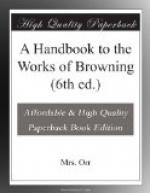[Footnote 122: It has been wrongly inferred from the passage in question that Mr. Browning admits the pretensions of science to solve the problems of the universe.]
[Footnote 123: The “goddess-sent plague” woven by Lachesis into the destiny of Admetus was a vengeance of Artemis which befell him on the day of his marriage. He had slighted her by omitting the usual sacrifice, and in punishment of this she sent a crowd of serpents to meet him in the nuptial chamber; but Apollo effected a reconciliation between them.]
[Footnote 124: He had, as a young man, so great an admiration for one of Bartoli’s works, “De’ Simboli trasportati al Morale,” that when he travelled he always carried it with him.]
[Footnote 125: Her reply was that if she possessed any influence over M. de Lorraine she would never use it to make him do anything so contrary to his honour and to his interests; she already sufficiently reproached herself for the marriage to which his friendship for her had impelled him; and would rather be “Marianne” to the end of her days than become Duchess on such conditions The reply has been necessarily modified in Mr. Browning’s more poetic rendering of the scene]
[Footnote 126: Indented,—for want of writing materials,—with a key on the wainscot of his cell.]
[Footnote 127: Created Lord Melcombe a year before his death: sufficiently known by his diary from March, 1748, to Feb., 1761. See its character in the Preface to the original edition by his relation, Henry Penruddocke Wyndham, 1784. Other notices will be found in “Edgeworth on Education,” Belsham’s “George II.,” and Hawkins’ “Life of Johnson.”]
[Footnote 128: Furini is also honourably mentioned in Pilkington’s “Dictionary of Painters,” revised by Fuseli, and till the middle of the present century the authoritative work on the subject. It is stated in the edition of 1805 that “many of his paintings are in Florence, which are deemed to add honour to the valuable collections of the nobility of that city.”]
[Footnote 129: The allusion in vol. xvi. p. 195, to the old artificer who could make men “believe” instead of merely “fancy” that what he presented to them was real, refers especially to the Greek painter Zeuxis; but it is suggested by the generally realistic character of Greek art.]
[Footnote 130: Described at p. 253 and onwards under the heading “Painter-like Beauty in the Open Air.”]
[Footnote 131: The last line and a half of the eighth stanza was directly suggested by the tragedy of AEschylus; the thunderstorm by another version of the Promethean myth.]
[Footnote 132: See Shelley’s translation from Moschus.]
[Footnote 133: Battle of Arbela.]
[Footnote 134: These lines were published in 1886 in the little volume entitled “The New Amphion.”]
[Footnote 135: Organist of Newcastle about 1750; author of “An Essay on Musical Expression” and other works.]




